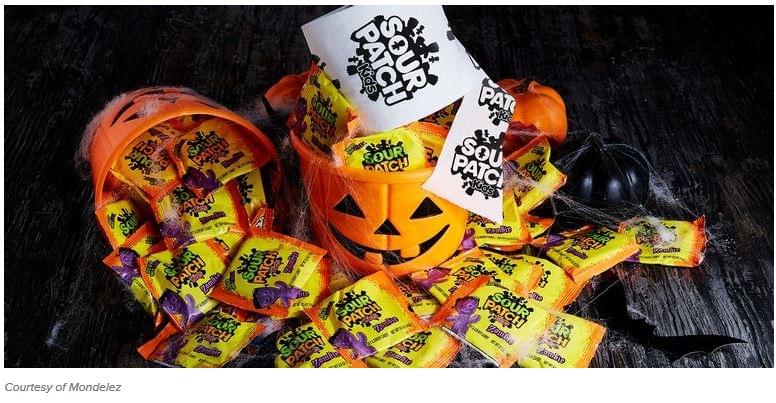Reverse Halloween with big brands
The pandemic has put candy companies, for whom the holiday generates about 14% of the sector’s annual sales in a creative challenge. With the Centers for Disease Control recommending against traditional trick-or-treating, marketers must walk a fine line of responsible messaging.

As we published before Walmart enhances the halloween season with „Trick or treat” programs in the outdoor parking lots. In addition to the retail giant, candy and snack makers have also lined up their brands to save this year’s Halloween.
Sweet shiver
A Piplsay poll of more than 30,000 Americans found 46% of parents will allow their kids to go trick-or-treating this year, while 23% are unsure. Regardless, enthusiasm is down, with 41% of respondents saying they were not looking forward to the holiday. Another research indicates that 74% of parents say Halloween is more important than ever this year.
As a result, candy and snack companies have had to get creative with their marketing this year. While some, like Kool-Aid and Sour Patch Kids, are running programs that bring Halloween to consumers’ doorsteps, others are embracing the holiday through digital activations.
Though it’s too soon to tell if the promotions work, candy sales so far have not been hurt by the unconventional holiday. U.S. candy sales in September were up 13% over last year, according to market researcher IRI and the National Confectioners Association. But the COVID-19 pandemic affects seasonal candy sales. Across the industry, candy sales were down 4.1% for Easter this year, according to Ad Age.
Candy delivered to families’ doors
Three different brands, Mondelez’s Sour Patch Kids figures, the Kool-Aid Man of Kraft Heinz and Hershey’s Reese’s decided to contactless deliver candies and snacks to families’ doors to remind them that there are still ways to get creative, have fun and enjoy „tricks and treats” in a safe way this Halloween.

The Mondelez-owned brand will deliver special Sour Patch Kids packages on Halloween night in 12 U.S. cities. Candy fans can nominate their city starting Oct. 8, and residents of the selected dozen cities on Oct. 31 can enter a sweepstakes to win on-demand delivery of Sour Patch Kids Zombies and branded toilet paper. Participants can enter by tweeting to the Sour Patch Kids’ account and hashtags #SourThenSweetHalloween #Sweepstakes, then view the brand’s Instagram Story to see if they’ve won.

Hershey’s Reese’s Peanut Butter Cups is giving Instagram users a chance to win a visit from a robotic candy dispenser shaped like the doorway to a haunted house. The “Reese’s Trick-or-Treat Door” hands out candy through its mail slot whenever someone says, “trick or treat. The Hershey-owned brand designed the door to travel through neighborhoods on motorized wheels while being steered by remote control. The nine-foot tall door has a Bluetooth-enabled speaker that responds to voice commands and hands out packs of Reese’s candy on a retractable shelf. With social distancing a bigger priority this year because of the pandemic, the robotic door allows Reese’s to be a part of Halloween even if traditional trick-or-treating is upended. Fans can win a visit from the door by following the @reeses account on Instagram and explaining where they want it delivered in a post that includes the #ReesesDoor hashtag.

Kool-Aid’s iconic brand mascot will visit the homes of fans in select cities as part of a reverse trick-or-treating campaign timed around Halloween. The Kraft Heinz-owned label will also feature brand characters delivering candy to select houses in cities around the country. Kool-Aid Man himself will deliver Scary Berry Jammers drink pouches, Ghoul-Aid Scary Berry popping candy and Kool-Aid Man costumes to contest winners. Visits will be determined through a sweepstakes run through the brand’s Twitter account.
Digital credits
Mars Wrigley, the confectioner behind brands like M&Ms, Snickers, Twix and Skittles, this week launched a month-long virtual Halloween experience called Treat Town. The company created cross-functional teams with the goal of providing a variety of ways for consumers for seasonal shopping as across the industry, candy sales were down 4.1% for Easter this year,
In Treat Town, consumers can give out virtual candy credits while trick-or-treaters can “visit” family and friends to collect the credits redeemable for real-world treats via online and real-world retailers. Users can decorate virtual houses with Halloween-themed decor as well as visit digital attractions like Disney’s Haunted Mansion and a virtual No. 18 M&M’S Toyota car for a “trunk or treat” experience. Personal avatars can be chosen from options like vampires and monsters and dressed in costumes.

Related news
Proposed new US dietary guidelines may prioritise plant proteins
The US Department of Health and Human Services (HHS) and…
Read more >Chocolate fever and spicy orders – this is how Hungarians celebrate Halloween
Special orders and new candy trends in Central Europe: intimate…
Read more >2024 Holiday Trends: Food Takes Center Stage as Consumers Plan Celebrations
From Halloween candy hoarding to hosting family gatherings, food is…
Read more >Related news
After a subdued year, the holiday season is strong
74% of online shoppers, around 3.1 million people, are preparing…
Read more >The majority of Hungarians spend less than 50 thousand forints on Christmas gifts, sustainability is an important aspect, but not the primary one
Gift-giving is an essential holiday tradition, but what really matters…
Read more >Battle of the regions: these are the most popular dishes according to Hungarians
Five times the national average of Mexican food is consumed…
Read more >








